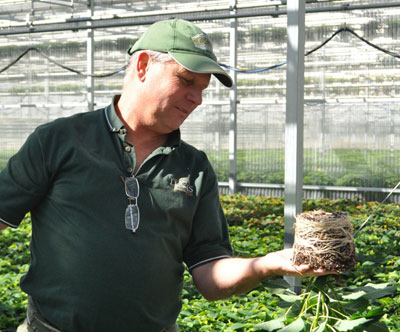
- Home
- Commercial Equipment
- Watering Tools & Hose
- Irrigation Systems
- Sprayers, Foggers, Foamers
- HAF Fans & Thermostats
- Humidity Management
- Specialized Tools
- Livestock Products
- Interiorscape
- Sanitation
- Battery Watering Cart
- Frost Protection
- Dramm YouTube Page
- DRAMMwater
- --
- Learning
- Warranty Registration
- Equipment Service & Repair
- Dramm Forum
- Dramm Blog
- Consumer Products
- News
- Contact
- Careers
- Privacy Policy
- Sustainability at Dramm
Dissolved Oxygen
How Healthy is Your Water?
Dissolved oxygen (DO) in your irrigation water is an untapped tool in horticulture. Increasing the DO level in your water increases root mass and fine root hairs resulting in increased growth, better fertilizer utilization and overall plant health. However, adding oxygen (O2) to your water is not that easy
 As oxygen is a gas, it needs to be injected and mixed in the right way to dissolve properly. There are many methods of adding DO to irrigation water. With one exception, however, the amount of oxygen in solution can never exceed the maximum saturation level possible for the temperature of the water.
As oxygen is a gas, it needs to be injected and mixed in the right way to dissolve properly. There are many methods of adding DO to irrigation water. With one exception, however, the amount of oxygen in solution can never exceed the maximum saturation level possible for the temperature of the water.
The maximum saturation level of dissolved oxygen in 70˚F water is approximately 9 ppm, not allowing very much room for extra with O2 alone.
In addition to the saturation limitation, that DO is quickly consumed by water and biofilm in the pipes as these present an oxidative demand.
DRAMMwater uses ozone (O3) as our disinfection oxidizer of choice. Unlike other disinfectants and most other ozone systems, our ozonation system design and process leaves the water super-saturated with high levels of dissolved oxygen, as much as 12 times higher than normal saturation limits. Also, unlike most disinfectants, ozone will completely eliminate the biofilm including the biofilm matrix, and other bio-matter in the water, allowing the levels of dissolved oxygen to remain high.
Most other disinfectants leave byproducts harmful to the plants you grow. Others may leave some dissolved oxygen, but never more than the maximum saturation level of O2.
An Ozone system that is properly designed and controlled results in exceptionally high levels (supersaturation) of DO in the water.
 | Most plants require at least 5 to 6 ppm of DO for healthy growth. Irrigation water with levels of DO lower than this can actually cause oxygen to leave the plant through the roots, impacting plant health and growth. The ozone systems from DRAMMwater can be designed to generate supersaturated dissolved oxygen levels in irrigation water of 30 to 40 ppm. The resulting improvements in plant growth and reductions in chemicals and fertilizers reported by our grower customers is significant. |
For more information on dissolved oxygen in irrigation water, download our white paper on the topic.

A Case for Complete Water Integration Services
Choosing the Right Dissolved Oxygen Meter

Benefits of Ozone and Dissolved Oxygen in Irrigation Water
Complete Water Management for Efficient Use of Water
Water Storage to Provide Capacity and Security

Download our whitepaper on dissolved oxygen above.

Latest forum topics:
Dissolved Oxygen
How Healthy is Your Water?
Dissolved oxygen (DO) in your irrigation water is an untapped tool in horticulture. Increasing the DO level in your water increases root mass and fine root hairs resulting in increased growth, better fertilizer utilization and overall plant health. However, adding oxygen (O2) to your water is not that easy
 As oxygen is a gas, it needs to be injected and mixed in the right way to dissolve properly. There are many methods of adding DO to irrigation water. With one exception, however, the amount of oxygen in solution can never exceed the maximum saturation level possible for the temperature of the water.
As oxygen is a gas, it needs to be injected and mixed in the right way to dissolve properly. There are many methods of adding DO to irrigation water. With one exception, however, the amount of oxygen in solution can never exceed the maximum saturation level possible for the temperature of the water.
The maximum saturation level of dissolved oxygen in 70˚F water is approximately 9 ppm, not allowing very much room for extra with O2 alone.
In addition to the saturation limitation, that DO is quickly consumed by water and biofilm in the pipes as these present an oxidative demand.
DRAMMwater uses ozone (O3) as our disinfection oxidizer of choice. Unlike other disinfectants and most other ozone systems, our ozonation system design and process leaves the water super-saturated with high levels of dissolved oxygen, as much as 12 times higher than normal saturation limits. Also, unlike most disinfectants, ozone will completely eliminate the biofilm including the biofilm matrix, and other bio-matter in the water, allowing the levels of dissolved oxygen to remain high.
Most other disinfectants leave byproducts harmful to the plants you grow. Others may leave some dissolved oxygen, but never more than the maximum saturation level of O2.
An Ozone system that is properly designed and controlled results in exceptionally high levels (supersaturation) of DO in the water.
 | Most plants require at least 5 to 6 ppm of DO for healthy growth. Irrigation water with levels of DO lower than this can actually cause oxygen to leave the plant through the roots, impacting plant health and growth. The ozone systems from DRAMMwater can be designed to generate supersaturated dissolved oxygen levels in irrigation water of 30 to 40 ppm. The resulting improvements in plant growth and reductions in chemicals and fertilizers reported by our grower customers is significant. |
For more information on dissolved oxygen in irrigation water, download our white paper on the topic.
Latest forum topics:
A Case for Complete Water Integration Services
Choosing the Right Dissolved Oxygen Meter
Benefits of Ozone and Dissolved Oxygen in Irrigation Water
Complete Water Management for Efficient Use of Water
Water Storage to Provide Capacity and Security
Download our whitepaper on dissolved oxygen above.